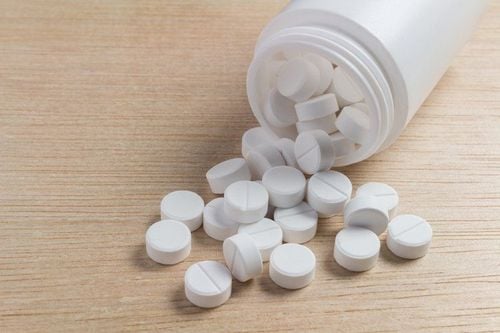This is an automatically translated article.
Safetamol 250 is prepared in the form of an oral solution with the main ingredient of the drug is Paracetamol 250mg/5ml. So what is the use of Safetamol 250 and how to use it?
1. Uses of Safetamol
Paracetamol in Safetamol is an active metabolite of phenacetin, which is an effective analgesic and antipyretic alternative to aspirin. However, paracetamol is not as effective in treating inflammation as aspirin.
At therapeutic doses, Paracetamol has little effect on the cardiovascular and respiratory systems as well as does not change the acid - base balance, nor does it cause irritation, scratches or stomach bleeding like when using salicylates. Because paracetamol has no effect on systemic cyclooxygenase, but only directly on cyclooxygenase/prostaglandin of the central nervous system.
Safetamol 250 is indicated in the following cases:
Pain: Safetamol 250 is used for temporary pain relief in the treatment of mild to moderate pain. The drug is most effective in reducing pain, especially in cases of low-intensity pain of non-visceral origin. Fever: Safetamol 250 is commonly used to lower body temperature in people with fever. However, the antipyretic effect is generally nonspecific, does not affect the course of the underlying disease, and this may mask the patient's illness. Safetamol 250 is contraindicated in the following cases:
People with hypersensitivity to paracetamol or any other ingredient of Safetamol 250. Severe liver failure Be careful when using Safetamol 250 in the following cases:
Current The safety of Safetamol 250 for pregnant women has not been established. Therefore, Safetamol 250 should only be used by pregnant women when absolutely necessary. Using paracetamol for women after giving birth and lactation, there are no undesirable effects in nursing infants. Safetamol 250 does not cause drowsiness and does not affect the ability to drive or use machines.
2. How to use and dose Safetamol 250
How to take Safetamol 250 as follows:
Safetamol 250 is used orally. Safetamol 250 should not be used for self-treatment for pain relief for more than 10 consecutive days in adults or more than 5 consecutive days in children, unless directed by a doctor. Because severe and persistent pain can be a sign of a medical condition that needs to be treated. Do not use Safetamol 250 for adults and children on their own to treat high fever (above 39.5°C), fever lasting more than 3 days, or recurrent fever, unless directed by a doctor. Because such a fever could be a sign of a serious medical condition that requires prompt diagnosis by a doctor. To minimize the risk of an overdose, children should not be given more than 5 doses of Safetamol 250 for pain relief or fever reduction within 24 hours, unless directed by a doctor. Dosage of Safetamol 250 should be according to the doctor's prescription, the reference dose is as follows:
Children under 6 years old: Use the drug as directed by the doctor or choose the drug with the appropriate concentration. Children 6-8 years old: Use dose 5ml/time, every 4-6 hours, maximum 4 times (1g) in 24 hours. Children 8 - 10 years old: Use a dose of 7.5ml / time, every 4-6 hours, up to 4 times (1.5g) in 24 hours. Children 10 -12 years old: Use dose 10ml/time, every 4-6 hours, maximum 4 times (2g) in 24 hours. Children 12-16 years old: Use dose 10-15ml/time, every 4-6 hours, maximum 4 times (3g) in 24 hours. Children 16-18 years old: Use dose 10-20ml/time, every 4-6 hours, maximum 4 times (4g) in 24 hours. Adults and children over 18 years old: Use dose 10-20ml/time, every 4-6 hours, maximum 4g in 24 hours. Treatment of an overdose of Safetamol 250:
Manifestation of an overdose of Safetamol 250: This is a condition of paracetamol poisoning, which can be caused by a single toxic dose, or by taking many large doses for a long time. Treatment of drug overdose Safetamol 250: Need early diagnosis, rapid determination of drug concentration in plasma. However, treatment should not be delayed pending laboratory results if the patient's history suggests a severe overdose. When paracetamol poisoning is severe, it is important to provide active supportive treatment. In all cases, gastric lavage should be performed, preferably within 4 hours of taking the drug.
3. Side effects of Safetamol 250
Uncommon side effects of Safetamol 250, including:
Ban. Nausea, vomiting. Hematopoietic disorders such as leukopenia, neutropenia, pancytopenia. Kidney disease Renal toxicity when long-term abuse of Safetamol 250. Rare side effects of Safetamol 250 include:
Steven-Johnson syndrome Toxic epidermal necrolysis Lyell's syndrome Acute generalized exanthematous pustulosis. Other side effects of Safetamol 250 include:
Hypersensitivity reactions. In the process of using Safetamol 250, if you notice any unusual symptoms, you should immediately notify your doctor, or go to a medical facility for timely treatment.
4. Interaction of Safetamol 250 with other drugs
Long-term and high-dose use of Safetamol 250 slightly increases the anticoagulant effect of coumarin and indandion derivatives.
Excessive and long-term alcohol consumption can increase the risk of liver toxicity of Safetamol 250.
Anticonvulsants (including phenytoin, barbiturates, carbamazepine) may increase the hepatotoxicity of paracetamol in Safetamol. 250, due to increased metabolism of drugs into substances that are toxic to the liver.
Concomitant use of isoniazid with paracetamol may also increase the risk of hepatotoxicity, but scientists have not determined the exact mechanism of this interaction. The risk of paracetamol in Safetamol 250 causing hepatotoxicity is significantly increased in patients taking larger than recommended doses while taking anticonvulsants or Isoniazid. There is usually no need to reduce the dose in patients receiving concomitant therapeutic doses of Safetamol 250 and anticonvulsants. However, it is necessary to limit self-administration of Safetamol 250 while using isoniazid or anticonvulsants.
Using Safetamol 250 together with Isoniazid and anti-tuberculosis drugs will increase the toxicity of paracetamol to the liver.
In addition to the above uses, if during the use of Safetamol 250, patients have any problems, they should contact a doctor for advice and appropriate indications.













